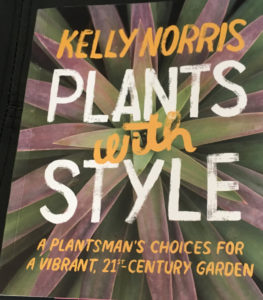 Plants with Style: A Plantsman’s Choices for a Vibrant, 21st Century Garden
Plants with Style: A Plantsman’s Choices for a Vibrant, 21st Century Garden
I frequently bemoan the lack of diversity and interest in our landscapes. My friend Kelly Norris, the Director of Horticulture at the Des Moines Botanical Garden, has taken it upon himself to direct us to new plants that are exciting and then shows us how to integrate them into our gardens.
As Kelly points out in Plants with Style, selecting plants that we love is an essential component of making a garden reflect who we are as well as a way of beautifying and improving our planet. Thus, he would say that style is about connecting love of plants with sense of place and ecology. This concept does not preclude adding plants that are not native, only that we should start with plants that epitomize our region and proceed from there.
None of the plants that Kelly highlights are fussy. In fact, one of his criteria is plants that will thrive, not just survive. Kelly is very well traveled and takes inspiration from many of the gardens that he has visited. He will be the first to tell you that he is a plant geek and loves working in the garden. This includes weeding and pruning and constant tweaking. After all, a garden is a living thing and conditions change or your taste changes.
Soil is always our starting point and Kelly points out that the soil of most areas of the country is clay. He quickly notes that the milkweeds (Asclepias), bluestars (Amsonia), and false indigos (Baptisia) have “a predilection for tough soils” while apprising us of species and cultivars of which we may be unaware.
The other predominant element of gardening is light: how much there is and the direction from which it comes. Kelly reminds us that light can be cast from the front or the back as well as overhead, enabling us to site plants to benefit from directional lighting. All too often, gardeners complain about shade but Kelly offers examples of genera that need shade to perform at their best. I love the inclusion of Synelesis aconitifolia as a reminder that shade plants can be taller than twelve inches. I’ve had it in my garden for several years and its unusual shredded, umbrella-like foliage is a delight.
The list of plants that Kelly mentions is not a boring compendium of what will work; rather, it is a series of humorous yet eloquent descriptions. I found myself laughing at many of these descriptions. I think the other emotion you will experience after reading this book is lust – plant lust, that is. A bonus of most of the plants mentioned in the book is that they are not on the deer menu.
Although he is not a landscape designer, Kelly thinks like one and quickly points out that structure frames the garden. Trees are the perfect example of structure, particularly their trunks that take stage once the leaves fall. A short riff on trunks elicits a list of trees with bark that spark the landscape, particularly in winter. When shrubs are used as hedges, they also provide structure in the garden but the ones that Kelly highlights are not the common choices. Hallelujah! Another section highlights some perennials that can be used as structural elements (Kelly calls them scaffolds that visually define the garden) because of their size. In contrast, he offers a selection of ground-covering plants as alternatives to PPI (pachysandra, periwinkle, and ivy).
Although many gardeners and hybridizers are looking for plants that bloom for long periods of time, Kelly reminds us that there are plants that are “emblems” of each season and that we should treasure them, e.g. tulips and daffs in spring, penstemons and lilies in summer, asters and mums in fall, and witch hazels and hellebores in winter.
Keeping all of this information in mind, Kelly then leads us to the creation of garden vignettes that will epitomize our style and personality. He shows us how to put plants together artfully, thus creating living communities that will, inevitably, change. The elements of stitching the vignettes together include color (with caveats about color of which you may not have thought), contrast (manipulation of texture through more than one season), foliage, understanding and maximizing plant personalities, and savoring the endings (berries). Add to all of this, at least one kitschy plant – not beloved by many but a must have for you, for whatever reason.
Throughout the book, I loved being able to say to myself I grow that and that and to add to my list of plants that I want to grow. As a keen horticulturist and a man with a keen eye, Kelly invites us into his mind and previews what our gardens can be. No matter how long you’ve gardened or been a designer, you want to read this book.
Norris, Kelly, Plants with Style: A Plantsman’s Choices for a Vibrant, 21st Century Garden, Timber Press, Portland, 2015, $24.95.


0 Comments